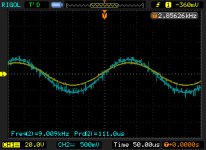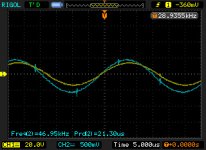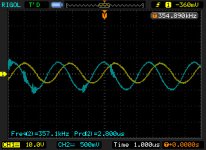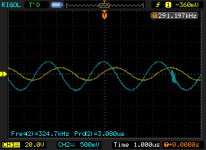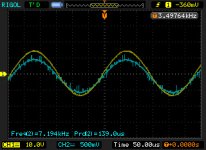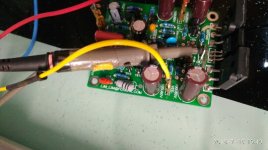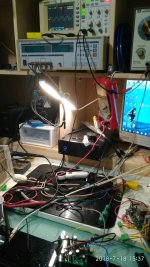Have a friend who has been asking me about about the MOSFET is not really can output 350 k sine wave. And attenuation is less than -3 db.
I take out the time to do a test.
From the test chart and see this is true. Can be achieved.
But it should be noted that the test I cancelled ZOBEL 10 ohm resistance.
I take out the time to do a test.
From the test chart and see this is true. Can be achieved.
But it should be noted that the test I cancelled ZOBEL 10 ohm resistance.
Attachments
There are plenty of MHz power amps. Apparently a substantial number of people consider this useful.
I wonder for what in audio someone need to amplify up to 350Khz?
I have the same idea with you.
I don't think this have what use. This is not the problem of the ear.
Sound is not likely to that sound.
But there is a friend, he has been consulting relevant issues. And said that cannot be measured.
So I was measured. And cut a picture.
There are plenty of MHz power amps. Apparently a substantial number of people consider this useful.
I think MHZ may refer to the PWM frequency in the digital amplifier.
The ordinary digital amplifier PWM at 300K-750K, working at 1 MHZ is not a difficult task.
This is not the frequency of the output signal. The same concept.
As far as I am concerned. The digital amplifier can hardly output more than 25K signal, because the inductance of its output is a large filter.
But there are some people, they need to be larger than 100 k output signal frequency.
This called ultrasonic amplifier in industrial application. Can be used to drive a few, special load.
Not speakers.
It is said (I don't agree nor disagree) that wide band amplifiers would warrant a better amplification in the audible range.
It kind of makes sense to me that if the fringes of amplification is where deterioration occurs and the middle of the band is always best, a wide band amplifier is something desirable. Theoretically the non-measurable sonic quality* tends to be better on wide band amplifiers
*As an engineer I have a really really hard time believing on non-measurable stuff....
I don't have the technical background to attest the veracity of this statement. I follow Paul McGowan's channel on youtube and he has a video about this which was condensed in the explanation above. Again, I don't know if I believe it or not, but I can see the reasoning.
It kind of makes sense to me that if the fringes of amplification is where deterioration occurs and the middle of the band is always best, a wide band amplifier is something desirable. Theoretically the non-measurable sonic quality* tends to be better on wide band amplifiers
*As an engineer I have a really really hard time believing on non-measurable stuff....
I don't have the technical background to attest the veracity of this statement. I follow Paul McGowan's channel on youtube and he has a video about this which was condensed in the explanation above. Again, I don't know if I believe it or not, but I can see the reasoning.
I think MHZ may refer to the PWM frequency in the digital amplifier.
You are free to think whatever you like 😛
Spectral is perhaps the oldest manufacturer of super-fi amps with extended bandwith and slew rate. Perhaps not tremendously popular as they refuse to pay for reviews, but still have some very loyal followers.
Here are some typical specs
Spectral Audio DMA-180 High-Current Reference Amplifier
There are plenty of MHz power amps. Apparently a substantial number of people consider this useful.
A good bandwidth gives better transient/dynamic response.
At high power levels an amp needs to move the signal between the rails very quickly. This is especially true of high voltage amps.
There are plenty of MHz power amps. Apparently a substantial number of people consider this useful.
As a radio amateur I can confirm this 😀
73 M0SBT
All the members here for so many years the debate does not end on the subject of the audio field.
In any case, even a baby whose hearing is the absoluteest will not notice what the adults think they notice. The amazing results of audio products are not deciphered by the human brain like a dolphin or a dog, so I do not see fit to produce amplifiers with such a wide bandwidth (over 100 kHz) In fact all the years I have created amplifiers and still straining today I do not allow bandwidth to be above 50 kHz. I emphasize again I do not argue with anyone who hears what he hears or thinks he hears just this sense in people really quite inferior.
When I was young I worked in a very special and respected company where I learned a lot in the field of audio, including very special inventions invented by this company.
Anyway I have respect to LJM
In any case, even a baby whose hearing is the absoluteest will not notice what the adults think they notice. The amazing results of audio products are not deciphered by the human brain like a dolphin or a dog, so I do not see fit to produce amplifiers with such a wide bandwidth (over 100 kHz) In fact all the years I have created amplifiers and still straining today I do not allow bandwidth to be above 50 kHz. I emphasize again I do not argue with anyone who hears what he hears or thinks he hears just this sense in people really quite inferior.
When I was young I worked in a very special and respected company where I learned a lot in the field of audio, including very special inventions invented by this company.
Anyway I have respect to LJM
*As a non-engineer I have a really really hard time believing on measurable stuff....
The institutionalized scientific method of generalizing, idealizing and simplifying things to absurdity, removed from their surrounding context is not believable to everybody. Mathematics serves that approach superbly well. Something is being measured, but the philosophical question arises, what is it?
Many amplifiers have insufficient bandwidth, hence an ungracious high frequency performance. Bandwidth is better to be seen as a dynamic capacity. Bandwidth falls off steeply with increasing current and other inversely related parameters and is not measurable by any instrumentation. An artificially generated sine wave constitutes a way too subliminal loading to be indicative.
motronix, what special inventions were made, if I may ask?
The institutionalized scientific method of generalizing, idealizing and simplifying things to absurdity, removed from their surrounding context is not believable to everybody. Mathematics serves that approach superbly well. Something is being measured, but the philosophical question arises, what is it?
Many amplifiers have insufficient bandwidth, hence an ungracious high frequency performance. Bandwidth is better to be seen as a dynamic capacity. Bandwidth falls off steeply with increasing current and other inversely related parameters and is not measurable by any instrumentation. An artificially generated sine wave constitutes a way too subliminal loading to be indicative.
motronix, what special inventions were made, if I may ask?
Last edited:
N101N
Search about Hafler and Rockford Fosgate Corporation
And I fully agree with you about what you wrote
Search about Hafler and Rockford Fosgate Corporation
And I fully agree with you about what you wrote
All the members here for so many years the debate does not end on the subject of the audio field.
In any case, even a baby whose hearing is the absoluteest will not notice what the adults think they notice. The amazing results of audio products are not deciphered by the human brain like a dolphin or a dog, so I do not see fit to produce amplifiers with such a wide bandwidth (over 100 kHz) In fact all the years I have created amplifiers and still straining today I do not allow bandwidth to be above 50 kHz. I emphasize again I do not argue with anyone who hears what he hears or thinks he hears just this sense in people really quite inferior.
When I was young I worked in a very special and respected company where I learned a lot in the field of audio, including very special inventions invented by this company.
Anyway I have respect to LJM
You're right. As long as it satisfies 20K HZ without attenuation. We can't hear higher frequencies.
In fact, many amplifiers. The frequency of 18K-20K HZ is not good enough.
For example, QUAD405, QUAD606 series products. They decay greatly at 18K HZ.
So we really should pay more attention to products with 15K-20K frequencies. At least for speakers.
But there are occasions. They need higher frequencies. 30K or 50K.
For example, an ultrasonic cleaner. Or an OFDM amplifier
Having more bandwidth than the signal doesn't achieve anything in itself, but can mean phase shifts are less at the edge of the audio band. Since we can't hear such phase errors its not really an issue for audio power amps.
So long as a power amp has an adequate slew rate for the signal bandwidth, its able to handle transients (unless they extend outside the signal bandwidth, which means they are interference anyway, not part of the signal).
Adding more bandwidth than needed achieves no improvement in handling of the signal, assuming the response in-band is flat to start with.
In practice to achieve nice flat response in band you will have more bandwidth than is needed, but that's not to handle transients/dynamics, its to make the response flat.
So long as a power amp has an adequate slew rate for the signal bandwidth, its able to handle transients (unless they extend outside the signal bandwidth, which means they are interference anyway, not part of the signal).
Adding more bandwidth than needed achieves no improvement in handling of the signal, assuming the response in-band is flat to start with.
In practice to achieve nice flat response in band you will have more bandwidth than is needed, but that's not to handle transients/dynamics, its to make the response flat.
Have a friend who has been asking me about about the MOSFET is not really can output 350 k sine wave. And attenuation is less than -3 db.
I take out the time to do a test.
From the test chart and see this is true. Can be achieved.
But it should be noted that the test I cancelled ZOBEL 10 ohm resistance.
Thank you very much for sharing those frequency responses 🙂
Just for curiosoty, do you ever tested the L7 project with an full frequency response analyser/bode plot?
PS: I extrapolated and tested this project with voltage +/- 80V @100 kHz 12ohm load, and it is amazing 🙂
100 kHz
Image ref: Ch1: output and Ch2: input
Last edited:
- Home
- Amplifiers
- Solid State
- L7 MOSFET amp test 20-350kHz
